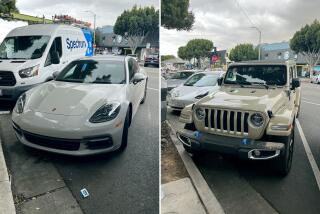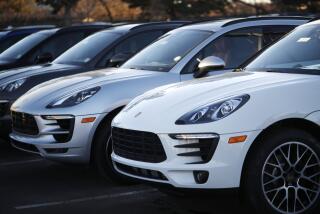Porsche Downshifts : Hurt by Sagging Dollar, Changing Consumer Tastes, Firm Is Altering Its Market Strategy
- Share via
Porsche AG, the West German sports car maker, is discovering life in the slow lane.
Once a sporty status symbol, Porsche seems to be losing some of its luster. Car owners who might have once considered a Porsche are now driving Ford Mustangs and Chevrolet Corvettes, said Kahled Abdel Majeed, an automobile industry analyst with the investment firm Drexel Burnham Lambert in New York.
“The Porsche is under significant attack from American and Japanese automobile makers,” he said. “Mechanically, they are still quite good. But they are no longer head and shoulders above the rest.”
On Tuesday, Porsche released dismal news from its headquarters in Frankfurt. The company said it expects worldwide car sales to drop 35% for the year that ends July 31. In response to lower sales, Porsche plans to cut its work force by 1,000, or 11.6%, over the next 15 months.
Those cuts follow earlier austerity moves. Last fall, Porsche reduced production at its Audi AG unit’s plant in Neckarsulm, Germany. At the same time, its U.S. unit, Porsche Cars North America, reduced its staff by about 26% through layoffs and attrition.
Porsche sales started slipping about a year ago, as the decline in the dollar made most imported goods, including Porsches, more expensive. That was an important development, because the United States accounts for about 60% of all Porsche sales, according to Martha McKinley, a spokeswoman at Porsche’s U.S. headquarters in Reno.
The base price of its most popular model, the Porsche 944, has soared to $30,995 from $27,840 a year ago, largely due to the dollar’s drop, McKinley said.
At those prices, Porsche had trouble with both ends of its market. Some car buyers turned to sporty but less expensive Mustangs or Corvettes, while others chose more exotic cars, such as Ferraris, said Majeed. “If a car buyer had a choice between a Porsche and a Ferrari, he would buy the Ferrari, because there are fewer on the road.”
Los Angeles Porsche dealer Brad Bodah said he thinks the production cutbacks will help Porsche sales. “They are making less, so the cars will be harder to get. When things are harder to get, people want them more,” he said.
But Glendale Porsche dealer John Hill noted that lower Porsche production might also make it harder for some dealers to get cars.
Hill said sales have improved from a year ago, “but they’re still not what we’d like.” He said Porsche had four price increases in the last year, and those hikes have discouraged buyers. The best-selling car, he said, is the $50,000 Porsche 911, first introduced in 1964.
Porsche isn’t the only luxury car maker hurt by the dollar’s slide. Last year, sales of imported luxury cars fell, with West German car makers especially hard hit. The slide continues this year. For example, BMW’s sales fell 12% during the first three months of this year, and Mercedes-Benz sales dropped 13%. But Porsche is suffering more; its sales fell 25% from January to March.
Porsche suffered a greater sales drop because, unlike its competitors, it hadn’t redesigned its cars for about five years, and Americans were bored with the same models, Majeed said. Meanwhile, American and Japanese car manufacturers had caught up with the Porsche, in terms of style and engineering. “The Porsche could no longer command a large performance premium,” Majeed said.
In response to a declining market, Porsche is changing its marketing strategy, said Chris Cedergren, an automobile industry analyst with J. D. Power & Associates in Westlake Village. He said the company is making fewer of its less expensive 944 models. At the same time, Porsche is bringing out new versions of its pricey 911 and 928 models to “attract more upper-crust sports car drivers,” Cedergren said.
Cedergren expects Porsche’s appeal to wealthy buyers to work. He said the company could sell 20,000 cars in the U.S. this year, more than the 18,000 projected by Porsche.
Porsche is moving away from mass-market competition, Majeed said. “They have resigned themselves to selling fewer cars, and will charge more for them.”
LUXURY CAR SALES
Most luxury car makers experienced a decline in sales between 1986 and 1987. Below, unit sales.
1987 1986 % Change Lincoln 142,017 137,280 +3.5 Volvo 106,539 113,267 -5.9 Saab 45,102 48,086 -6.2 Jaguar 22,919 24,464 -6.3 BMW 87,839 96,759 -9.2 Mercedes-Benz 89,918 99,314 -9.5 Cadillac 275,683 319,005 -13.6 Porsche 23,632 30,471 -22.4 Acura 109,470 52,869 *
*Comparison not valid since production began in March, 1986.
Source: Ward’s Automotive Reports





